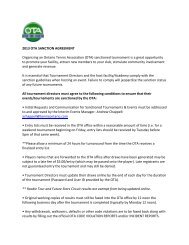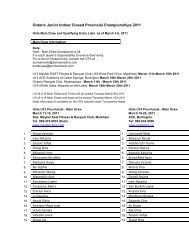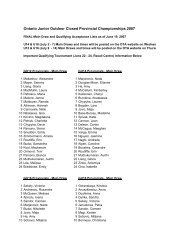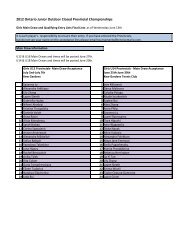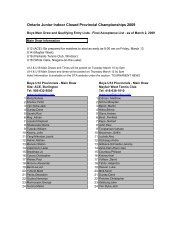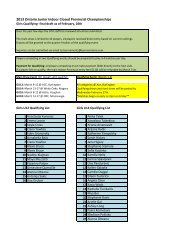YEAR ENd 2008 - Ontario Tennis Association
YEAR ENd 2008 - Ontario Tennis Association
YEAR ENd 2008 - Ontario Tennis Association
You also want an ePaper? Increase the reach of your titles
YUMPU automatically turns print PDFs into web optimized ePapers that Google loves.
PRESIDENT'S MESSAGE<br />
At the first regional general<br />
meeting I attended three<br />
years ago, Adrian Baldeo,<br />
Chair of <strong>Tennis</strong> Toronto,<br />
invited each club to share their successes<br />
of the past year, and the challenges they<br />
faced in the year ahead. It was an eye<br />
opener; not only for me, but for the rest<br />
of the group listening to what some<br />
clubs had achieved, irrespective of the<br />
size of their membership. The same was<br />
true when clubs described the challenges<br />
they faced in the coming year. I<br />
later shared Adrian’s idea with the other<br />
Regional Chairs and a number of them<br />
now include a similar session as part of<br />
their AGMs.<br />
This past fall I attended five OTA<br />
regional annual general meetings.<br />
Those meetings allow me to meet club<br />
Presidents on a personal level and hear<br />
about their successes in <strong>2008</strong> and the<br />
challenges they face in 2009. What follows<br />
in a summary of my notes from<br />
those five meetings. I have not included<br />
everything that was discussed. I have<br />
instead limited myself to common elements.<br />
Beginning on a positive note, a<br />
majority of clubs in all regions reported<br />
an increase in both adult and junior<br />
membership requiring, in several<br />
instances, a need for waiting lists. In<br />
areas where a decrease was reported,<br />
Once players developed a feeling<br />
of being a part of something<br />
special, participation increased.<br />
reasons included an economic downturn<br />
in the region, increased unemployment,<br />
and financial hardship. Other reasons<br />
included aging membership, a high<br />
yearly membership turnover, and difficulty<br />
recruiting new members.<br />
Clubs reporting either stable or<br />
increased membership were proactive<br />
in providing tennis programming that<br />
matched the instructional needs and levels<br />
of ability of members of all ages. Led<br />
by enthusiastic tennis pros and volunteers<br />
these clubs provided: free lessons<br />
for new members, new member<br />
orientation, junior camps, progressive<br />
tennis, family nights,<br />
house leagues, round robins,<br />
inter-club leagues, a variety of<br />
tournament structures, a fitness<br />
program, club socials, a<br />
Pro-Am event and, in one case,<br />
a cancer fundraiser in honour<br />
of a deceased member.<br />
Junior camps were by far<br />
the most successful activity<br />
with record numbers reported.<br />
Several clubs also reached<br />
out to disadvantaged youth<br />
and either waived or obtained<br />
sponsors to cover camp fees.<br />
Some smaller clubs worked<br />
together and shared pros and<br />
programs. Clubs that focussed<br />
on being “a people place” with<br />
strong community connections<br />
tended to draw more new and<br />
casual players to the court.<br />
Once players developed a feeling<br />
of being a part of something<br />
special, participation<br />
increased.<br />
In terms of 2009, the most<br />
commonly reported challenge continues<br />
to be the development of a good working<br />
relationship with the municipal authorities<br />
who own the land upon which most<br />
community clubs are located. While we<br />
recognize that tennis is not the<br />
only sport competing for local<br />
recreational funding, a more<br />
open and transparent process<br />
is required. Currently, regional<br />
associations and clubs feel as if they<br />
have little or no input into a process that<br />
affects them directly.<br />
The current economic crisis will<br />
certainly impact 2009. Job cuts and<br />
unprecedented cost-cutting measures by<br />
companies will translate into decreased<br />
membership, particularly in areas hardest<br />
hit by the economic downturn. A<br />
recent article in The Hamilton Spectator<br />
stated that “Canada’s economy is in a<br />
period of deep uncertainty that is difficult<br />
to see beyond.” Bank of Canada<br />
Michel Lecavalier, OTA President<br />
with James Blake at Rogers Cup<br />
governor Mark Carney does not foresee<br />
a rebound in the Canadian economy<br />
until 2010, and even then, predicts that<br />
it will be a modest one. Over the next<br />
two years, the OTA and its member<br />
clubs must budget carefully and manage<br />
resources prudently.<br />
However, in an attempt to stimulate<br />
the economy, the federal budget<br />
included a commitment to invest in<br />
Canada’s recreation infrastructure. An<br />
infrastructure funding program is being<br />
developed that will focus on renewing<br />
and building community sport and recreation<br />
facilities. The initiative provides<br />
$500 million over two years to cover the<br />
cost of eligible projects. Details regarding<br />
how to access these funds have not<br />
yet been released. OTA members will be<br />
kept informed of further developments<br />
via the OTA’s weekly news letter.<br />
<strong>2008</strong> successes, there were many!<br />
2009 will be all about challenges...<br />
4<br />
OTA <strong>YEAR</strong>BOOK / WINTER 2009




